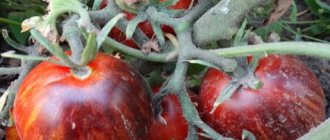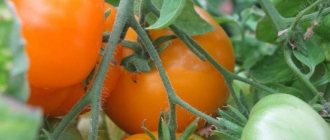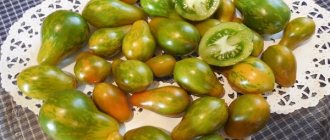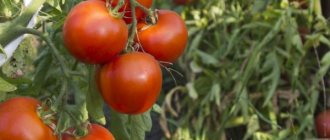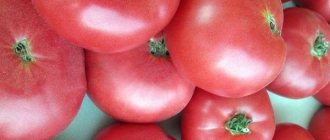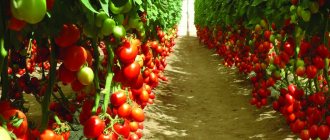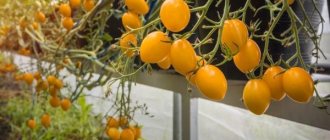The article presents the Gnome tomato: description of the variety, photos, the best varieties with characteristics.
By developing new crops, scientists intend to achieve more and more benefits from crops. In the project, which will be discussed later, the main goal was to create plants that would feel comfortable and develop even if they were in a limited space.
They also wanted to achieve abundant fruiting and high immunity to common tomato diseases.
They succeeded. In addition, experimentally, after many experiments, they managed to develop more than 20 different tomato crops. According to the name of the project, the variety was also called Gnome. In addition, breeders continue to work on crops at the present time.
Tomato Gnome: variety description, photo
Tomato Gnome: variety description, photo
We associate the word “gnome” with something small, tiny, and we would like to think that these are low-growing varieties of tomatoes. However, it is not. A tomato bush can reach even one and a half meters, and maybe a little more than 40 cm. The fruits also differ in weight. They can be either 50 grams or almost 200 grams. Although all the crops developed in this project are different from each other, they have similar characteristics. Knowing them, an experienced gardener can immediately distinguish a variety from other crops.
The bushes grow very neatly and do not overgrow, which is a big advantage for gardeners with a small plot. The ripening of the fruits of this variety is mid-summer, which indicates the early ripening of the product.
This culture is characterized by one main trunk, or at most two. The stems do not branch, they look healthy and powerful, not thick and have the shape of a trunk. Plants feel comfortable even where there is very little free space, when almost every free meter of usable land is planted with some kind of crop; even in an overgrown garden, tomatoes bear fruit well.
Each crop is suitable for growing at home, for example on a balcony, in a pot. All crops are invulnerable to common diseases and have a high level of fruiting. The fruits of these crops ripen to a fairly large size.
If we talk about the differences between fruits from each other, there are a lot of shades and colors. Also, the mass of the tomato itself varies widely. The fruits can ripen either red, light pink or even purple; white, brown and green fruits are also characteristic of the crop. In addition, striped tomatoes look interesting.
If we talk about the pulp, it has an excellent taste. Also, depending on a particular type, the fruits can be sweet and even spicy. This intriguing statement will make everyone try to grow all types of this variety.
General characteristics of the series
Despite the intriguing name, the plants of the “Gnome” tomato series are not at all low-growing. The average height of representatives of various varieties varies from 45 cm to 130-140 cm, and the weight of the fruit is from 50 to 180 grams.
All varieties of tomatoes in the Dwart series have their own characteristics, but they are united by several characteristics, thanks to which they can be easily distinguished from other varietal plants:
- Tomatoes do not need pinching;
- The plants are compact and occupy a small area, which is a big plus for summer residents with small plots;
- Precocity. The fruits ripen already in mid-July;
- It has one, very rarely two, slightly branched trunks. Tomato bushes are predominantly standard;
- The foliage is wrinkled and emerald green;
- The stems are strong and thick;
- All varieties of “Gnomes” grow well even in dense plantings and give an excellent harvest;
- Any varieties can be grown in tubs, on a balcony or loggia;
- Tomatoes are distinguished by their high yield and stable immunity to almost all diseases;
- Almost all dwarf varieties belong to the large-fruited group.
Interesting! Tomatoes in this series are highly resistant to macrosporiosis.
Each subspecies differs not only in the mass of fruits, but also in shape, and, most importantly, color. The color range of tomatoes from the “Gnome” series is very diverse: from classic red and pink to unusual white, brown, green, and purple. There are also the usual shades of yellow and orange, but there are also such unique ones as the striped “Gnomes”.
The taste of the fruit deserves the highest praise. They have such a wide range of flavors - from sweet to spicy with a slight tangy aftertaste - that there is a desire to grow and appreciate each variety.
Classification of the dwarf series
The Dwart tomato series includes more than 20 different varieties, which are very difficult to figure out the first time. Therefore, there was a need to classify varieties. Each group included plants whose fruits differ in color:
- Aronia;
- Green-fruited;
- Rose-fruited;
- White-fruited;
- Yellow-fruited;
- Bicolors (that is, two-color);
- Orange-fruited.
The wide range of tomatoes from the Gnome series proves that nothing is impossible for true amateur breeders. The painstaking work to develop new varieties continues to this day, and in the coming years new representatives of the “Dwarf” project will appear on the market.
Tomato Gnome: description of the variety, types of crops
Tomato Gnome: description of the variety, types of crops
In general, there are more than two dozen different varieties from the Gnome series. To make it clearer, further in the article there is a classification of the created varieties, which are divided precisely by the color of the fruit. So they have the following names: black-fruited, green-fruited, white-fruited, yellow-fruited, orange-fruited, two-color pink-fruited.
Such a large number and variety of varieties, which differ significantly from each other, once again emphasizes the enthusiasm and interest with which scientists have worked for many years and continue to work on the Gnome project to this day.
Features of planting, care and cultivation
Even novice gardeners can grow this variety. Seeds need to be sown 40-60 days before the expected date of planting in the ground. You can first soak them for 30-40 minutes in an organic stimulant. This manipulation will allow them to germinate faster and increase resistance to external factors.
Diving should be done when 2 true leaves appear. Planting of seedlings is carried out after the presence of 6-7 leaves. For 1 sq. It is recommended to place no more than 4 representatives of the plant. The bush care scheme consists of:
- fertilizing with minerals;
- timely watering;
- preventive measures to combat diseases and pests.
If a sufficient amount of liquid is given with fertilizers during the formation of the ovary, as well as during its maturation, then the yield per 1 sq. m can be 7-8 kg. It is only important to remember the rule of the “golden mean”. Anything in moderation is good. Fruit ripening occurs 100-110 days after germination.
Tomato variety Gnome: the best varieties
The Gnome varieties include a very large number of plants that differ from each other in both the number of fruits and the timing of harvest ripening. In addition, varieties differ, as mentioned above, in the color of the fruit. What they have in common is the undemanding nature of plants, their unpretentiousness. Growing this variety does not require a lot of effort and time, as well as a large area of land. As a rule, tomatoes grow well in small areas if they are planted at about 7 bushes per square meter.
According to the creators, the breeders, their products do not require constant monitoring of stepchildren, and the bushes do not need to be tied up, which also usually takes a lot of time for the gardener. The only exception is those plants that have produced a lot of fruits, since the branches may break or the bush may fall.
The following are the characteristics that Tomato Gnome has, a description of the variety and some of its varieties loved by gardeners.
Pink Passion.
Tomato variety Gnome: the best varieties
It has a determinate bush type. Refers to crops with abundant fruiting. The height of the stem of a plant growing in a greenhouse can reach a meter. If the tomato is planted in open beds, then half a meter. The bush grows in the form of a trunk with one main main stem. There is no need to form it regularly. The shape and color of the leaves resembles potatoes. The plant has high immunity to such a popular disease as late blight and many other diseases. After 100 days, you can pick ripe fruits.
As a rule, the fruits grow large, quite heavy, approximately more than 200 g each. The plant, which has several flower clusters, bears five or three fruits. Ripe fruits are heart-shaped and have a characteristic red-pink skin. From a distance you can mistake them for Victoria. There are very few seeds inside the pulp, and the pulp itself is quite juicy and dense. These tomatoes taste sweet and sour and have a pronounced aroma. Like any other tomatoes, the fruits of this variety are rich in nutrients and microelements.
The fruits of the variety are loved to be consumed raw, also added as ingredients for preparing a variety of dishes and side dishes, they can be preserved and pickled. In addition, the fruits are suitable for long-term travel, after which they retain their appearance and taste.
Thus, the variety that was described above is a clear representative of the work carried out by the project. That is, the breeders achieved what they wanted and created a neat, miniature bush that has a high level of fruiting. The fruits are very tasty and healthy. In addition, the culture is vulnerable to most diseases.
Thus, if you follow all the rules for caring for the plant, which consists of regular watering, weeding, loosening it, as well as feeding with mineral complex fertilizers, it will be possible to collect approximately 8 kg of fruit from a square meter of tomato ridge. In general, all plants in this series deserve to be on the list of healthy nutrition products, since they contain few acids and a large amount of dry matter.
Golden heart
The tomato bush Golden Heart is low-growing, usually has a length of 50 cm, the maximum can grow up to 80 cm. It has a determinate bush type, so it can be grown either in a greenhouse, in a hotbed or simply on an open ridge.
Since the bush grows neat branches that do not diverge much to the sides and are small in size, it is necessary to form this plant only at the very beginning of its development. This variety is suitable for growing on the balcony in ordinary flower pots. The fruits of this variety are characterized by abundant simultaneous ripening, which makes harvesting easier. As a rule, a lot of fruits ripen. If this happens, the bush should be tied to some constructed structure or support so that the plant does not break.
This described crop is considered an early ripening crop, since the crop can be harvested within 3 months after you see the shoots. The fruits weigh approximately 100 g. The shrub produces a peduncle, where approximately 4-5 heart-shaped fruits ripen. This variety name refers to the beautiful sunny color of the fruit peel. In addition, the skin of the fruit appears shiny and reflective. Speaking of taste, we can note the fleshy pulp, which is characterized by a small presence of seeds. The peel does not crack even during long-term storage and transportation, maintaining its beautiful appearance.
The variety, similar to the previous variety, has sweet fruits with a slight sourness, as well as a delicate aroma. The fruits are actively consumed fresh. In addition, they are added to various dishes during cooking. They also make preparations for the winter. The fruits are rich in beta-carotene and vitamin C, which is of great benefit to the human body. If you are going to transport the fruits or store them for a long period of time, then this variety will be optimal for you, especially if you collect the fruits while they are still green in color.
One of the disadvantages of the variety is that the plants are demanding on the soil; they grow well on fertile, rich soil, which must be constantly moistened and fed. If you do not neglect this care, the plant will reward you with a large number of fruits, approximately 7 kg per square meter of ridge.
Thong
This variety with a very unusual name has an average fruit ripening period and a fairly tall stem, the length of which can grow up to one and a half meters. A variety was developed with the recommendation of growing it in open space.
The leaves of the plant are quite wide, and the fruits have the shape of an ellipse. The moment of fruit ripening is very interesting. If you watch it carefully, you can first see the dark green color of the peel with a slight purple tint, then when ripe, the fruits will have a pink color. The tomatoes are quite large, up to 300 g each. If the fruit is cut, you can see the dark cherry color of the pulp, which has a very dense texture and sweet taste.
Plants do not need to be constantly pinched, and they also have high immunity to common diseases. In addition, the bush feels comfortable with some temporary temperature changes, is quite resistant to drought and drafts, and bears fruit well. It has a large harvest, and can also be considered a champion in terms of shelf life and resistance to transportation. These fruits are consumed fresh, made into salads, and tomato juice is also prepared. In addition, the fruits are excellent for winter preparations. The variety is distinguished by the uniqueness of its fruits.
Striped Anto
This is a short, strong bush that grows to a maximum of one meter. A variety has been created with a recommendation for cultivation outside of greenhouse conditions; it has an average period of fruit ripeness. This variety is characterized by a wide variety of fruit colors. Tomatoes can bear purple, pink, yellow, and even olive fruits. When the fruit is fully ripe, it takes on a tiger color. If we talk about the shape of the fruit, it is round.
The fruits themselves are small in size, approximately 70 g each, and can ripen in the amount of seven pieces at a time, located on one flowering raceme. The juicy pulp has a very sweet, pronounced taste. According to statistics, this is the best variety developed by the Gnome project. This is evidenced by its absolute unpretentiousness in care and high resistance to a variety of diseases, as well as changeable weather. Plus, the number of fruits is very large. There is no need to control the growth of stepchildren. If you follow the rules of plant care, the tomato will reward you with 5 kg of ripe fruits, which will be stored for quite a long time, while leaving the external and taste properties unchanged, and it can also be transported over long distances.
The fruits of this variety also have universal use. In addition to fresh consumption and canning, tomatoes can even be dried and frozen.
Purple Heart
Like all previous subspecies, tomatoes have a very unusual name, determinate type of bush. The fruits have an average ripening period. You can grow plants in any conditions. The shape of the bush is in the form of a trunk, the stem reaches half a meter in height. This plant does not need to be pinched. The fruit has a heart shape and is also red-brown in color. The pulp contains a lot of juice, and, on the contrary, a small amount of seeds.
If you follow the rules of care, you can collect about 3 kg from one bush of such a plant. Despite the short growth of the stem, the fruits are quite heavy, about 200 g each. Since all Gnome series crops have a very slow growth rate, it is necessary to grow seedlings about a couple of months before you plan to plant them on the site. Here it is optimal to plant about 6 bushes per square meter. The taste of the fruits of this variety is very bright, pronounced, fleshy pulp. Tomatoes of this culture are very popular to be consumed fresh. Tomato juice, tomato paste and various sauces are prepared from the fruits.
A fight with a shadow
This plant, which is characterized by an average period of fruit ripening, has a semi-determinate bush type. The culture is created for growing in an open area, and will also grow well in a greenhouse and greenhouse. Quite resistant to various tomato diseases. After about 4 months, ripe fruits can be collected. The stem grows no more than a meter long. However, you still need to tie up the branches, mainly when the fruits are ripening. The bush is formed, as a rule, into two or three stems, and if necessary, then stepson. One flowering cluster of this crop can produce up to 5 fruits, which have a bright orange color with crimson splashes. The plant also has an unusual fruit shape. It is oval here and resembles a plum. The taste of the pulp is similar to the pulp of melon. This plant is also best grown through seedlings, which must be started a couple of months before the expected planting date. One square meter will fit 6 tomato bushes well. If you follow all the rules for caring for the plant, you can remove 15 kg of fruit from one square meter of ridge.
In addition, those who have already grown this variety on the site note that during the period of fruit ripening, the tomato bushes resemble a New Year's tree, which was decorated with various colored balls. They also note the excellent taste of the fruit, which is usually sweet, sometimes sweet and sour. These characteristics allow the fruits of the crop to be used universally. Speaking about the “Shadow Fighting” tomato variety, it should be noted that the color of the plant’s leaves changes during slight cold spells. So they will turn purple, and as soon as the temperature rises back, the tops will again take on a green color.
Cheerful gnome
The plant has a determinate bush type. It is distinguished by high fruiting and average fruit ripeness. It is recommended to grow this variety in open space. The bushes are compact, do not exceed half a meter in height and do not need to be pinched at all.
The shape of the red fruit is oval with a pronounced tip. The peel is quite strong and smooth. The fruits have a distinct taste, are not large in size - no more than 90 g each, and are not prone to cracking. The fruits are very good for cooking for future use. They are also added to all kinds of dishes. Plants are grown using seedlings, similar to previous varieties. The planting frequency will be approximately 6 bushes per square meter.
Big gnome
This is a fairly recently bred variety, so not many gardeners have tried it yet, and it is impossible to create a complete description of the plant. It is only known that the fruits have an average period of maturity, the bush is semi-determinate. The variety is considered high-yielding. The tomato is suitable for growing in a greenhouse, as well as in open areas. The stem does not exceed 1 meter in height. The plant is not demanding and does not need to be pinched. Only during fruiting is it better to tie up the bushes to prevent them from breaking.
Like all previous varieties of the Gnome series, the plants are resistant to common diseases such as late blight. The fruits have a bright red color and a round shape. Their sizes are quite large, approximately 300 g each. If we talk about taste, the structure of the pulp is dense with a small number of seeds. Thus, the fruits are suitable for universal use: for fresh consumption, and they can also be frozen or dried for the winter. The variety is grown using seedlings, after which the bushes are planted 4 pieces per square meter.
Wild Fred
This crop has an average fruiting period, is distinguished by an abundant harvest, has a determinate type of bush, and grows no more than half a meter in height. The culture is completely undemanding. She doesn't need to be stepsoned. The fruits are characterized by a brown color with a slightly purple tint. The weight of each fruit is small, approximately 200 g. The fruits are very rich in taste and have a unique aroma. They are used both for preparing salads and added during the preparation of juices and sauces. The seeds of this crop are grown using seedlings according to a planting pattern similar to previous crops.
Ferokovkai
The variety has a determinate bush type, medium fruit ripening times and abundant fruiting. It is recommended for growing in a greenhouse, since the stem size can reach one and a half meters in height. If you plant the bush in open ground, it will grow a little over half a meter in height. Up to 5-6 fruits can ripen on one flowering cluster. The fruits have an ellipse shape and a wide variety of shades, both on the surface and inside the fruit. Tomatoes are quite large, can reach approximately 350 g each. The peel is dense and not prone to cracking. The fruit pulp tastes juicy, dense, sweet and sour.
Dwarf
This crop belongs to the early ripening varieties. So after 3 months you can harvest. These low-growing plants are completely unpretentious. The variety can be grown on the balcony, in a greenhouse, and in open areas. The stem reaches 50 cm in height, the bush has few branches. The fruits are circular in shape and have a standard bright red color. The weight of each fruit does not exceed 60 g. The fruits have a long shelf life and do not crack.
Similar to all previous varieties, tomatoes have a universal scope. From one square meter of tomato ridge, you can harvest up to 7 kg of fruit if you follow the rules of agricultural technology. The variety is grown using seedlings, then the bushes are planted with six plants per square meter.
Some subspecies of the series
The weight of these tomatoes is 200-220 grams, and their appearance resembles strawberries.
Golden Heart – early ripening
Its productivity is high, and all the fruits ripen almost simultaneously. Tomatoes are golden yellow in color with shiny skin, thin but dense, not cracking. The advantages of Golden Heart tomatoes are that they are stored fresh for a long time and can withstand transportation over long distances well.
The fruits of the Thong subspecies are round and flattened.
Perhaps this is the most interesting subtype of Dwarf. Unripe fruits are almost purple at first. As they ripen, the color begins to change, with ripe fruits turning purple with an olive tint. Moreover, on one bush there are no two fruits with the same color.
Striped Anto also has an interesting coloring. At first, the fruits are yellow, purple, olive or pink. Ripe tomatoes take on a brick-red hue with black stripes.
Purple Heart
The name completely describes these tomatoes, and their color is purple-chocolate.
A fight with a shadow
It looks like a Christmas tree, because bright multi-colored tomatoes grow on one Gnome bush.
- Gnome tomatoes are not grown;
- the bushes are at least slightly spreading, but compact and do not require space;
- early ripening fruits;
- each bush with one trunk (occasionally – two trunks);
- leaves with an emerald tint, and their surface is wrinkled;
- stems are strong and thick;
- You can grow Cheerful Gnome tomatoes even on a balcony or loggia, for this you will need a barrel;
- The variety is high-yielding, resistant to diseases characteristic of nightshades, which corresponds to the description. Macrosporia and late blight do not affect bushes.
Another good thing about tomatoes from this series is that they don’t care about changeable weather. Even if the summer is not very hot, you will have “gnomes”.
It is interesting that each variety of Dwarf differs not only in taste, although it is always pleasant, but also in the color of the skin and pulp. As for taste, the differences in this regard between the types of Gnome tomatoes, judging by the reviews, are striking. Dwarf tomatoes have a sweet, sour and even spicy taste. Everything is very tasty! Among the subspecies there are tomatoes with large or small fruits, with early and late ripening, but at the same time they are resistant to a number of diseases - this is an important feature. 6 or even 7 bushes are planted on one square meter of land!
The cheerful gnome, as the description says, does not have to be attached to a stick. At the same time, gardeners advise from experience: the tomato harvest is often large, so tie the branches with synthetic thread.
Some subspecies of the series
The weight of these tomatoes is 200-220 grams, and their appearance resembles strawberries.
Golden Heart – early ripening
Its productivity is high, and all the fruits ripen almost simultaneously. Tomatoes are golden yellow in color with shiny skin, thin but dense, not cracking. The advantages of Golden Heart tomatoes are that they are stored fresh for a long time and can withstand transportation over long distances well.
The fruits of the Thong subspecies are round and flattened.
Perhaps this is the most interesting subtype of Dwarf. Unripe fruits are almost purple at first. As they ripen, the color begins to change, with ripe fruits turning purple with an olive tint. Moreover, on one bush there are no two fruits with the same color.
Striped Anto also has an interesting coloring. At first, the fruits are yellow, purple, olive or pink. Ripe tomatoes take on a brick-red hue with black stripes.
Large gnome is one of the new subspecies of the variety. The fruits are dark pink. They are shaped like a flattened ball.
Rules of agricultural technology
Caring for and growing tomatoes bred by the Gnome project is similar to the agricultural technology of any variety of tomatoes. Almost all of them are grown using seedlings. It becomes possible to sow seeds directly into open ground only in very warm climatic conditions. Where the weather is not particularly warm, it is best to grow tomatoes in greenhouses so that the fruits have time to ripen before the end of the summer season. You should follow the rules for planting crops and do not exceed the frequency of planting per square meter.
In general, the average time for sowing seeds for seedlings is approximately 2 months before the planned planting of tomatoes on the site. However, in the Northern regions you should start growing seedlings at the end of winter. The seedlings also need to be carefully looked after, watered regularly, placed in a sunny place and various ready-made fertilizer complexes applied. When approximately two or three true leaves have formed, the seedlings are picked.
If you are doing balcony gardening, you need to prepare the pot in advance. You should create a drainage of at least 2 cm, and also select a suitable soil, which should be loose and rich in nutrients. As mentioned above, all varieties in this series are resistant to low temperatures. However, seedlings should still be hardened off before planting seedlings in open ground. Hardening should begin gradually. First, the plants should be taken out into the open air for at least an hour, gradually increasing the time spent outside. After about 10 days of hardening have passed, tomato seedlings can be planted in open ground.
Since the plants are short-growing, most of them do not need to be tied up, since they have fairly powerful trunks. But for very productive varieties, during the fruiting period it is necessary to provide a support and tie the branches so that the bush does not break under the weight of the fruit.
The advantage of all varieties bred by the Gnome project is the lack of growth of stepsons, so there is no need to shoot the bushes. The only thing is that if the plants branch very strongly or if you form it into several stems, then during the active growth of green mass you will have to control their presence. All crops love moderate watering. Therefore, soil moisture should be controlled to avoid root rotting. It is also good to remove the first leaves.
After you have transplanted the seedlings, any variety from the series will need standard care, which consists of regularly removing weeds, feeding, watering and loosening the soil. By following all these simple rules, you can get a very large harvest and please yourself and your loved ones.
Tips for growing tomatoes yourself: from Shooting to Harvest
For better fruiting, feed tomato bushes with balanced organic fertilizers until the plants have fully grown. An organic kelp solution can be sprayed on tomatoes several times during the growing season to increase disease resistance.
Pruning also helps with many tomato varieties. Concentrate your tomato pruning efforts in two places: anything that grows above the support or touches the ceiling of the greenhouse, and the so-called “stepchildren” stems that grow between the main trunk and the outer leaf (for non-hybrid varieties only).
If you live in a cold region, use a greenhouse to maintain a higher soil temperature (29 C) while the plant gains vigor and color.
Allow the soil around the plant to dry out slightly between each watering. Using mulch around plants can retain moisture and reduce weeds.
Soil Conditions for Growing Tomatoes
- Preferred soil pH (see soil pH for more information): 5.5 to 7.5
- Soil temperature for growth: 15 to 29 degrees Celsius
